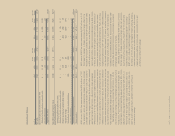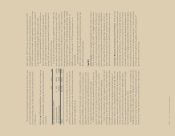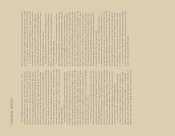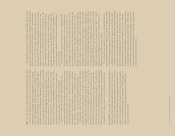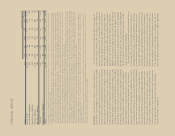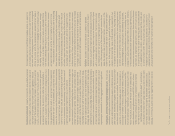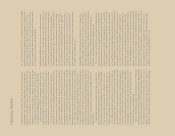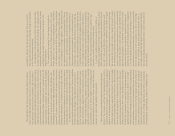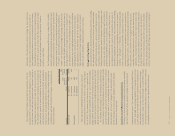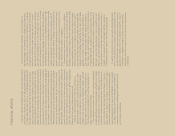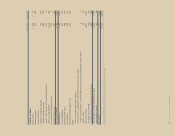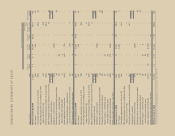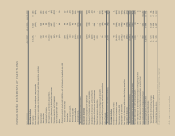Sara Lee 2011 Annual Report Download - page 75
Download and view the complete annual report
Please find page 75 of the 2011 Sara Lee annual report below. You can navigate through the pages in the report by either clicking on the pages listed below, or by using the keyword search tool below to find specific information within the annual report.
72/73 Sara Lee Corporation and Subsidiaries
The impairment test for identifiable intangible assets not subject to
amortization consists of a comparison of the fair value of the intangi-
ble asset with its carrying amount. An impairment loss is recognized
for the amount by which the carrying value exceeds the fair value of
the asset. The fair value of the intangible asset is measured using
the royalty savings method. In making this assessment, manage-
ment relies on a number of factors to discount anticipated future
cash flows including operating results, business plans and present
value techniques. Rates used to discount cash flows are depend-
ent upon interest rates and the cost of capital at a point in time.
There are inherent assumptions and estimates used in developing
future cash flows requiring management’s judgment in applying these
assumptions and estimates to the analysis of intangible asset
impairment including projecting revenues, interest rates, the cost
of capital, royalty rates and tax rates. Many of the factors used in
assessing fair value are outside the control of management and
it is reasonably likely that assumptions and estimates will change
in future periods. These changes can result in future impairments.
Note 4 to the Consolidated Financial Statements sets out the impact
of charges taken to recognize the impairment of intangible assets
and the factors which led to changes in estimates and assumptions.
Goodwill Goodwill is not amortized but is subject to periodic
assessments of impairment and is discussed further in Note 3.
Goodwill is assessed for impairment at least annually, in the fourth
quarter, and as triggering events may arise. Recoverability of good-
will is evaluated using a two-step process. The first step involves
a comparison of the fair value of a reporting unit with its carrying
value. If the carrying value of the reporting unit exceeds its fair
value, the second step of the process involves a comparison of the
implied fair value and carrying value of the goodwill of that report-
ing unit. If the carrying value of the goodwill of a reporting unit
exceeds the implied fair value of that goodwill, an impairment loss
is recognized in an amount equal to the excess. Reporting units are
business components one level below the operating segment level
for which discrete financial information is available and reviewed by
segment management. In evaluating the recoverability of goodwill,
it is necessary to estimate the fair value of the reporting units. In
making this assessment, management relies on a number of factors
to discount anticipated future cash flows including operating results,
business plans and present value techniques. Rates used to discount
cash flows are dependent upon interest rates and the cost of capital
at a point in time. The fair value of reporting units is estimated based
on a weighting of two models – a discounted cash flow model and
a market multiple model. The discounted cash flow model uses
management’s business plans and projections as the basis for
expected future cash flows for the first three years and a 2% to 4%
residual growth rate thereafter. The market multiple approach
Impairment of Property Property is tested for recoverability whenever
events or changes in circumstances indicate that its carrying value
may not be recoverable. Such events include significant adverse
changes in the business climate, the impact of significant customer
losses, current period operating or cash flow losses, forecasted
continuing losses or a current expectation that an asset group will
be disposed of before the end of its useful life. Recoverability of
property is evaluated by a comparison of the carrying amount of an
asset or asset group to future net undiscounted cash flows expected
to be generated by the asset or asset group. If these comparisons
indicate that an asset is not recoverable, the impairment loss recog-
nized is the amount by which the carrying amount of the asset exceeds
the estimated fair value. When an impairment loss is recognized for
assets to be held and used, the adjusted carrying amount of those
assets is depreciated over its remaining useful life. Restoration of
a previously recognized impairment loss is not allowed.
There are inherent uncertainties associated with these judgments
and estimates and it is reasonably likely that impairment charges can
change from period to period. Note 4 to the Consolidated Financial
Statements discloses the impairment charges recognized by the
corporation and the factors which caused these charges. It is also
reasonably likely that the sale of a business can result in the recog-
nition of an impairment that differs from that anticipated prior to the
closing date. Given the corporation’s ongoing efforts to improve oper-
ating efficiency, it is reasonably likely that future restructuring actions
could result in decisions to dispose of other assets before the end
of their useful life and it is reasonably likely that the impact of these
decisions would result in impairment and other related costs includ-
ing employee severance that in the aggregate would be significant.
Trademarks and Other Identifiable Intangible Assets The primary
identifiable intangible assets of the corporation are trademarks and
customer relationships acquired in business combinations and com-
puter software. Identifiable intangibles with finite lives are amortized
and those with indefinite lives are not amortized. The estimated
useful life of an identifiable intangible asset to the corporation is
based upon a number of factors, including the effects of demand,
competition, expected changes in distribution channels and the
level of maintenance expenditures required to obtain future cash
flows. As of July 2, 2011, the net book value of trademarks and
other identifiable intangible assets was $322 million, of which
$266 million is being amortized. The anticipated amortization
over the next five years is $165 million.
Identifiable intangible assets that are subject to amortization
are evaluated for impairment using a process similar to that used
to evaluate elements of property. Identifiable intangible assets
not subject to amortization are assessed for impairment at least
annually, in the fourth quarter, and as triggering events may arise.


